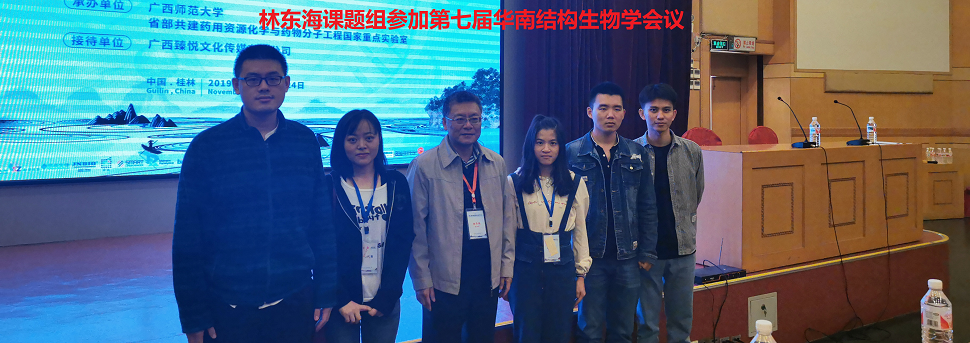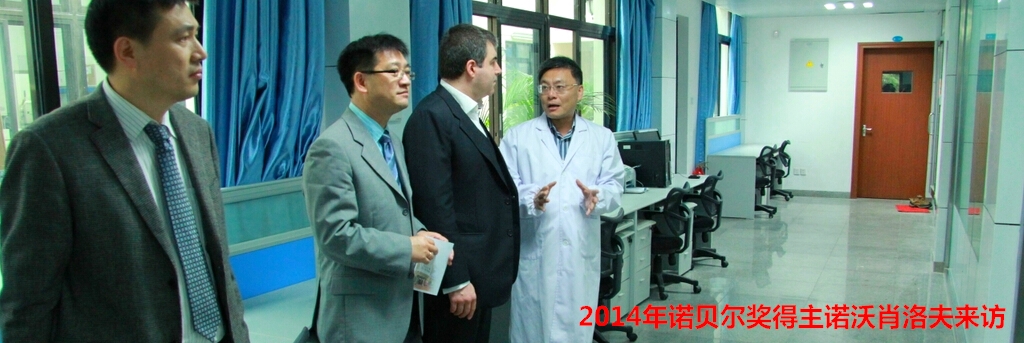
新闻(更多)
- 祝贺课题组博士生邱旭、刘西,硕士生周周澳、祁真、吴文芳顺利通过学位论文答辩
- 热烈祝贺课题组博士生邱旭获厦门大学2025年校级奖学金
- 2025年1月4日 生物核磁共振课题组开展爬山健身活动
- 2024年9月13日 林东海教授课题组举行中秋博饼活动
- 2024年6月5日 祝贺课题组博士生周雨,硕士生张悦和于佳鑫顺利通过学位论文答辩
- 2024年04月07日 厦门大学菲律宾校友会精英代表团莅临本课题组参访交流
- 2024年01月10日 新年开门红!祝贺本课题组发表2024年第一篇SCI论文!
- 2023年12月31日 林东海课题组科研工作成果小结
- 2023年12月30日 林东海教授课题组组织素质拓展活动
- 第九届华南结构生物学论坛暨医药合成生物产业创新大会在深圳光明科学城召开
- 2023年11月20日 本课题组与李勤喜课题组开展合作研究揭示在能量应激情况下肝脏中乙酸生成的机理及生理意义
- 2023年11月17日-19日 林东海教授课题组参加“第九届华南结构生物学论坛暨医药合成生物产业创新大会”
- 2023年10月 祝贺课题组组长林东海教授荣获2023年度ABBS突出贡献编委奖
- 2023年10月27-29日 林东海教授课题组参加第三届中国生物物理学会代谢组学分会年会
- 2023年10月22日 祝贺课题组勇夺“闽都·南强杯”厦研体育竞赛乙组第一名
- 2023年09月22日 本课题组举办温馨、快乐的中秋博饼活动
- 2023年6月28日 祝贺本课题组23届毕业生顺利毕业
- 2023年03月31日 本课题组与厦门海洋三所蔡兵研究员课题组联合举行科研合作研讨会
- 2023年03月30日 赴厦门市妇幼保健院进行学术交流,加强围产医学的合作研究
- 2023年1月31日 课题组研究发现乳酸在骨骼肌代谢调控中发挥重要的作用
- 2023年01月11日 本课题组原创论文被选中作为ABBS 2022年度精选推荐
联系方式
联系电话: 0592-2186078
Email: dhlin@xmu.edu.cn
福建省厦门市思明区思明南路422号
厦门大学化学化工学院高场核磁中心高-102室
课题组介绍
一.本课题组介绍
课题组依托于厦门大学高场核磁共振中心,拥有多台国际先进的高场核磁共振谱仪(850兆、600兆等),主要开展生物核磁共振谱学技术在化学、生物学、医学、药学、海洋科学和环境科学等方面的应用研究,包括代谢组学研究和结构生物学研究。 近年来,本课题组在国际学术刊物 (Molecular Cancer,Molecular Cell, Nature Chemical Biology, Nature Communication, Theranostics, Journal of Cachexia, Sarcopenia and Muscle,Mol. Cell. Proteomics, Leukemia,FASEB, Cell Reports, Journal of Proteomics Research, Journal of Medicinal Chemistry, Journal of Cellular Physiology, Skeletal Muscle, Cancer Science, Free Radical Biology and Medicine, Journal of Biological Chemistry, Molecular Microbiology, International Journal of Molecular Science, Biomolecules, Applied Microbiology and Biotechnology , Frontiers in Pharmacology,Frontiers in Molecular Biosciences, Marine Drug, molecules, metabolites等)上发表SCI论文230 多篇。
我们热忱欢迎国内外研究团队与本课题组开展合作研究,也欢迎努力向上的青年学子报考本课题组研究生,也欢迎志同道合的青年博士来本课题组开展博士后和访问学者等研究工作。
Introduction of Our Research Group
Our research group is based at the High-Field NMR Center of Xiamen University, which is equipped with several state-of-the-art high-field NMR spectrometers (850 MHz, 600 MHz, etc.). We focus on advancing the application of biological NMR spectroscopy in diverse fields, including chemistry, biology, medicine, pharmacy, marine science, and environmental science, with particular emphasis on metabolomics and structural biology.
In recent years, our group has published more than 2340 SCI-indexed papers in leading international journals such as Molecular Cancer, Molecular Cell, Nature Chemical Biology, Nature Communications, Theranostics, Journal of Cachexia, Sarcopenia and Muscle, Molecular & Cellular Proteomics, Leukemia, FASEB Journal, Cell Reports, Journal of Proteome Research, Journal of Medicinal Chemistry, Analytic Chemistry, Journal of Cellular Physiology, Skeletal Muscle, Cancer Science, Free Radical Biology and Medicine, Journal of Biological Chemistry, Molecular Microbiology, International Journal of Molecular Sciences, Biomolecules, Applied Microbiology and Biotechnology, Frontiers in Pharmacology, Frontiers in Molecular Biosciences, Marine Drugs, Molecules, Metabolites, among others.
We warmly welcome collaborations with research teams worldwide, motivated students to pursue graduate studies in our group, and like-minded young scholars to join us as postdoctoral fellows or visiting scholars.
课题组介绍海报:
![]() 生物核磁课题组介绍(Introduction to the Bio-NMR Group)
生物核磁课题组介绍(Introduction to the Bio-NMR Group)
![]() NMR实验室谱仪性能介绍(NMR Laboratory Spectrometer Performance)
NMR实验室谱仪性能介绍(NMR Laboratory Spectrometer Performance)
二.主要研究方向 (Main Research Directions)
1. 代谢组学研究:
我们主要利用NMR和LC-MS技术开展代谢组学研究,包括:
(1) 阐述重大疾病的代谢特征,发展早期诊断和术后检测方法;
(2) 阐述疾病发生发展过程中代谢特征和代谢物水平的变化和受扰动的代谢通路,揭示发病机制,寻找逆转病理状态的干预方法;
(3) 评估药物的药效和毒性,阐明所干预的代谢通路和作用机制;
(4) 阐述运动人体的代谢特征及运动改变的特征性代谢物和作用的重要代谢通路,揭示运动效应的分子机理。所研究的生物样品:血清、血浆、尿液、唾液、羊水、脑脊液等生物体液,组织,细胞,微生物和粪便,等等。
Metabolomics Studies
We conduct metabolomics research primarily using NMR and LC-MS technologies, focusing on:
(1) Characterizing the metabolic features of major diseases and developing methods for early diagnosis and postoperative monitoring;
(2) Investigating alterations in metabolic profiles, metabolite levels, and perturbed metabolic pathways during disease progression, to uncover mechanisms of pathogenesis and identify potential interventions for reversing pathological states;
(3) Evaluating the efficacy and toxicity of drugs, and elucidating the metabolic pathways and mechanisms underlying their actions;
(4) Defining the metabolic characteristics of the human body during exercise, identifying exercise-associated metabolites and altered metabolic pathways, and revealing the molecular mechanisms underlying exercise physiology.
The biological samples studied include serum, plasma, urine, saliva, amniotic fluid, and other body fluids, as well as tissues, cells, microorganisms, and fecal samples.
代谢组学研究简介海报 (Introduction Poster of Our Metabolomics Research):
![]() 生物核磁共振课题组研究简介墙报-代谢组学(Biological Nuclear Magnetic Resonance (BNMR) Group Research Briefing - Metabolomics)
生物核磁共振课题组研究简介墙报-代谢组学(Biological Nuclear Magnetic Resonance (BNMR) Group Research Briefing - Metabolomics)
2. 结构生物学研究 :
我们主要利用NMR和X-射线晶体衍射技术开展结构生物学研究,包括:
(1) 测定蛋白质、多肽及其复合物的溶液结构或晶体结构;
(2) 研究蛋白质、多肽与配体的相互作用;
(3) 测定蛋白质的动力学;
(4) 基于结构的药物筛选,等等。
Structural Biology Studies:
We carry out structural biology research primarily using biological NMR spectroscopy and X-ray crystallography, focusing on:
(1) Determining the solution and crystal structures of proteins, peptides, and their complexes;
(2) Investigating the interactions between proteins, peptides, and ligands;
(3) Characterizing the dynamics and conformational flexibility of proteins;
(4) Performing structure-based drug discovery and screening.
结构生物学研究简介海报 (Introduction Poster of Our Structural Biology Research):
结构生物学研究简介海报:
![]() 生物核磁共振课题组研究简介墙报-结构生物学(Biological Nuclear Magnetic Resonance (BNMR) Group Research Briefing - Structural Biology)
生物核磁共振课题组研究简介墙报-结构生物学(Biological Nuclear Magnetic Resonance (BNMR) Group Research Briefing - Structural Biology)
三.主要研究兴趣
1. 结核分枝杆菌重要蛋白质的结构与功能研究,着重研究反式翻译过程关键蛋白的结构、动力学及其相互作用等,基于靶蛋白的结构设计和筛选先导化合物,克服抗结核病药物的耐药性。
2. 人源朊病毒蛋白及其致病突变体的结构、动力学研究, 着重研究G127V多态性保护作用的结构基础,理解朊病毒蛋白的致病机理,为朊病毒病的防治与药物研发提供理论依据
3. 肿瘤的代谢特征、生物标志物、紊乱的代谢通路和发病机制,研究肠癌恶病质、肺癌恶病质、胃癌恶病质、胶质瘤恶病质的代谢模式、特征性代谢物、关键代谢通路等, 尤其感兴趣肿瘤外泌体在肿瘤恶病质的发生发展中的作用。
4. 心血管病、糖尿病等代谢性疾病的代谢特征、生物标志物、关键代谢通路和发病机制等,尤其感兴趣红细胞在心血管、动脉粥样硬化和糖尿病等疾病发病过程中的作用。
5. 衰老导致的器官功能减退的分子机制及减缓衰老进程的干预方法(药物, 营养,运动等)的作用机制, 特别关注肌少症。
Main Research Interests
1. Tuberculosis Protein Structure and Function
Investigating the structure and function of key proteins in Mycobacterium tuberculosis, with an emphasis on the structure, dynamics, and interactions of proteins involved in the trans-translation process. Based on target protein structures, we design and screen lead compounds aimed at overcoming resistance to anti-tuberculosis drugs.
2. Prion Protein Structure and Pathogenesis
Conducting structural and dynamic studies of human prion proteins and their pathogenic mutants, with particular focus on elucidating the structural basis of the protective effect of the G127V polymorphism. These studies aim to clarify the pathogenic mechanisms of prion proteins and provide a theoretical foundation for the prevention, treatment, and drug development of prion diseases.
3. Cancer Metabolism and Exosomes
Exploring the metabolic characteristics, biomarkers, disrupted metabolic pathways, and pathogenic mechanisms of tumors. We focus on the metabolic patterns, characteristic metabolites, and key pathways associated with cancer cachexia in colorectal cancer, lung cancer, gastric cancer, and glioma. We are particularly interested in the role of tumor-derived exosomes in the onset and progression of cancer cachexia.
4. Metabolic Disorders: Cardiovascular Disease and Diabetes
Investigating the metabolic features, biomarkers, key pathways, and pathogenic mechanisms of cardiovascular diseases, diabetes, and related metabolic disorders. A major focus is on the role of erythrocytes in the development of cardiovascular disease, atherosclerosis, and diabetes.
5. Aging and Sarcopenia
Studying the molecular mechanisms underlying age-related decline in organ function and the mechanisms of interventions (e.g., drugs, nutrition, exercise) that slow the aging process, with particular focus on sarcopenia.
四.科研条件 (Research Conditions)
本课题组所在的厦门大学高场核磁共振中心配置了850兆,600兆,500 兆三台液态核磁共振谱仪以及配套的仪器设施(如LC-MS联用系统),并具备开展生物化学和分子生物学实验所需要的仪器设备(HPLC,FPLC,MS,低温层析柜、高速冷冻离心机、振荡摇床、超净台、电泳设备、细胞超声破碎仪、酶标仪、PCR仪、分光光度计、-80°C冰箱,圆二色谱仪,荧光光谱仪,动态光散射仪,等等),还配备了蛋白质晶体生长实验室和细胞生物学实验室。
The High-Field NMR Center of Xiamen University, where our group is based, is equipped with three high-performance liquid-state NMR spectrometers (850 MHz, 600 MHz, and 500 MHz) along with complementary instrumentation, including an LC-MS system. The center also houses a wide range of facilities required for biochemical and molecular biology experiments, such as HPLC, FPLC, MS, cryogenic chromatography cabinets, high-speed refrigerated centrifuges, orbital shakers, biosafety cabinets, electrophoresis systems, ultrasonic cell disruptors, microplate readers, PCR instruments, spectrophotometers, -80 °C freezers, circular dichroism spectrometers, fluorescence spectrometers, and dynamic light scattering analyzers.
In addition, the center is equipped with dedicated protein crystallization laboratories and cell biology laboratories, providing comprehensive support for multidisciplinary research.
附件【NMR实验室谱仪性能介绍.pdf】
附件【生物核磁共振课题组研究简介墙报-结构生物学.pdf】
附件【生物核磁共振课题组研究简介墙报-代谢组学.pdf】
代表性论文
- Metabolomics-driven discovery of targets for cancer cachexia Journal of Cachexia, Sarcopenia and Muscle, 15(3): 781-793 (2024).
- NMRformer: a Transformer-based deep learning framework for peak assignment in 1D 1H NMR spectroscopy Analytical Chemistry, 19(5): 838-852 (2024).
- Serum Metabolites in Diagnostics and Therapeutics Frontiers in Molecular Biosciences, 11:1528799. DOI: 10.3389/fmolb.2024.1528799 (2024).
- The proto-oncogene tyrosine kinase c-SRC facilitates glioblastoma progression by remodeling fatty acid synthesis Nature Communication, 15: 7455. DOI: 10.1038/s41467-024-51444-0 (2024).
- Exploring the therapeutic potential of ethyl 3-hydroxybutyrate in alleviating skeletal muscle wasting in cancer cachexia Biomolecules, 13(9): 1330. DOI: 10.3390/biom13091330 (2023).
- Hepatic conversion of acetyl-CoA to acetate plays crucial roles in energy stresses elife, 12:RP87419. DOI: 10.7554/eLife.87419.3 (2023).
- Metabolic adaptations of microbacterium sediminis YLB-01 in Deep-Sea High-Pressure Environments Applied Microbiology and Biotechnology, 108(1): 170 DOI: 10.1007/s00253-023-12906-5 (2023).
- Metabolomic analysis of trehalose alleviating oxidative stress in myoblasts International Journal of Molecular Sciences, 24:13346. DOI: 10.3390/ijms241713346 (2023).
- Targeting cancer cachexia: molecular mechanisms and clinical study MedComm, 10;3(4):e164. DOI: 10.1002/mco2.164. (2022).
- β-hydroxybutyrate in cardiovascular diseases: a minor metabolite of great expectations Frontiers in Molecular Biosciences, 9:823602. DOI: 10.3389/fmolb.2022.823602 (2022).
- Filamentous GLS1 promotes ROS-induced apoptosis upon glutamine deprivation via insufficient asparagine synthesis. Molecular cell, 82(10):1821-1835.e6. DOI: 10.1016/j.molcel.2022.03.016 (2022).
- A Sparse Model-Inspired Deep Thresholding Network for Exponential Signal Reconstruction—Application in Fast Biological Spectrosc IEEE Transactions on Neural Networks and Learning System, 34(10):7578-7592. DOI: 10.1109/TNNLS.2022.3144580 (2022).
- ZEB1 enhances Warburg effect to facilitate tumorigenesis and metastasis of HCC by transcriptionally activating PFKM Theranostics, 11(12):5926-5938. DOI: 10.7150/thno.56490 (2021).
- Taurine protects C2C12 myoblasts from impaired cell proliferation and myotube differentiation under cisplatin-induced ROS exposu Frontiers in Molecular Biosciences, 8:685362. DOI: 10.3389/fmolb.2021.685362 (2021).
- Different expressions of HIF-1α and metabolism in brain and major visceral organs of acute hypoxic mice International Journal of Molecular Sciences, 22(13):6705. DOI: 10.3390/ijms22136705 (2021).
- Small-molecule inhibitor targeting the Hsp70-Bim protein-protein interaction in CML cells overcomes BCR-ABL-independent TKI resi Leukemia., 35(10):2862-2874. DOI: 10.1038/s41375-021-01283-5 (2021).
- NMR-Based metabolomic analysis of the anticancer effect of metformin treatment on cholangiocarcinoma cells Frontiers in oncology, 10:570516. DOI: 10.3389/fonc.2020.570516 (2020).
- Nuclear magnetic resonance-based tissue metabolomic analysis clarifies molecular mechanisms of gastric carcinogenesis. Cancer science, 111(9):3195-3209. DOI: 10.1111/cas.14443 (2020).
- Discovery and Evaluation of New Compounds Targeting Ribosomal Protein S1 in Antibiotic-Resistant Mycobacterium Tuberculosis European journal of medicinal chemistry, 196:112317. DOI: 10.1016/j.ejmech.2020.112317 (2020).
- NMR-based metabonomic analysis of HUVEC cells during replicative senescence. Aging (Albany NY), 12(4):3626-3646. DOI: 10.18632/aging.102834 (2020).






